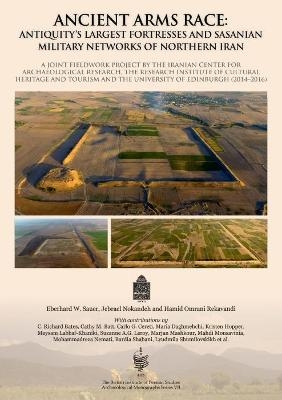
Ancient Arms Race: Antiquity's Largest Fortresses and Sasanian Military Networks of Northern Iran
A joint fieldwork project by the Iranian Center for Archaeological Research, the Research Institute of Cultural Heritage and Tourism and the University of Edinburgh (2014–2016)
Seiten
2022
Oxbow Books (Verlag)
978-1-78925-462-4 (ISBN)
Oxbow Books (Verlag)
978-1-78925-462-4 (ISBN)
Explores the role of the Iranian fortresses on the Romano-Persian frontier in the Late Antique period.
Which ancient army boasted the largest fortifications, and how did the competitive build-up of military capabilities shape world history? Few realise that imperial Rome had a serious competitor in Late Antiquity. Late Roman legionary bases, normally no larger than 5 ha, were dwarfed by Sasanian fortresses, often covering 40 ha, sometimes even 125–175 ha. The latter did not necessarily house permanent garrisons but sheltered large armies temporarily – perhaps numbering 10,000–50,000 men each. Even Roman camps and fortresses of the Early and High Empire did not reach the dimensions of their later Persian counterparts. The longest fort-lined wall of the late antique world was also Persian. Persia built up, between the fourth and sixth centuries AD, the most massive military infrastructure of any ancient or medieval Near Eastern empire – if not the ancient and medieval world. Much of the known defensive network was directed against Persia’s powerful neighbours in the north rather than the west. This may reflect differences in archaeological visibility more than troop numbers. Urban garrisons in the Romano-Persian frontier zone are much harder to identify than vast geometric compounds in marginal northern lands. Recent excavations in Iran have enabled us to precision-date two of the largest fortresses of Southwest Asia, both larger than any in the Roman world. Excavations in a Gorgan Wall fort have shed much new light on frontier life, and we have unearthed a massive bridge nearby. A sonar survey has traced the terminal of the Tammisheh Wall, now submerged under the waters of the Caspian Sea. Further work has focused on a vast city and settlements in the hinterland. Persia’s Imperial Power, our previous project, had already shed much light on the Great Wall of Gorgan, but it was our recent fieldwork that has thrown the sheer magnitude of Sasanian military infrastructure into sharp relief.
Which ancient army boasted the largest fortifications, and how did the competitive build-up of military capabilities shape world history? Few realise that imperial Rome had a serious competitor in Late Antiquity. Late Roman legionary bases, normally no larger than 5 ha, were dwarfed by Sasanian fortresses, often covering 40 ha, sometimes even 125–175 ha. The latter did not necessarily house permanent garrisons but sheltered large armies temporarily – perhaps numbering 10,000–50,000 men each. Even Roman camps and fortresses of the Early and High Empire did not reach the dimensions of their later Persian counterparts. The longest fort-lined wall of the late antique world was also Persian. Persia built up, between the fourth and sixth centuries AD, the most massive military infrastructure of any ancient or medieval Near Eastern empire – if not the ancient and medieval world. Much of the known defensive network was directed against Persia’s powerful neighbours in the north rather than the west. This may reflect differences in archaeological visibility more than troop numbers. Urban garrisons in the Romano-Persian frontier zone are much harder to identify than vast geometric compounds in marginal northern lands. Recent excavations in Iran have enabled us to precision-date two of the largest fortresses of Southwest Asia, both larger than any in the Roman world. Excavations in a Gorgan Wall fort have shed much new light on frontier life, and we have unearthed a massive bridge nearby. A sonar survey has traced the terminal of the Tammisheh Wall, now submerged under the waters of the Caspian Sea. Further work has focused on a vast city and settlements in the hinterland. Persia’s Imperial Power, our previous project, had already shed much light on the Great Wall of Gorgan, but it was our recent fieldwork that has thrown the sheer magnitude of Sasanian military infrastructure into sharp relief.
Eberhard Sauer is Professor of Roman Archaeology at the University of Edinburgh. Jebrael Nokandeh is Director of the National Museum of Iran, Tehran, and Research Fellow at the Research Institute of Cultural Heritage and Tourism. Hamid Omrani Rekavandi is Director of the Great Gorgan Wall Cultural Heritage Base.
| Erscheinungsdatum | 01.11.2022 |
|---|---|
| Zusatzinfo | colour |
| Verlagsort | Oxford |
| Sprache | englisch |
| Maße | 210 x 297 mm |
| Themenwelt | Geisteswissenschaften ► Archäologie |
| Geschichte ► Allgemeine Geschichte ► Vor- und Frühgeschichte | |
| Geisteswissenschaften ► Geschichte ► Regional- / Ländergeschichte | |
| ISBN-10 | 1-78925-462-0 / 1789254620 |
| ISBN-13 | 978-1-78925-462-4 / 9781789254624 |
| Zustand | Neuware |
| Informationen gemäß Produktsicherheitsverordnung (GPSR) | |
| Haben Sie eine Frage zum Produkt? |
Mehr entdecken
aus dem Bereich
aus dem Bereich
Schulbuch Klassen 7/8 (G9)
Buch | Hardcover (2015)
Klett (Verlag)
31,50 €
Buch | Softcover (2004)
Cornelsen Verlag
25,99 €



